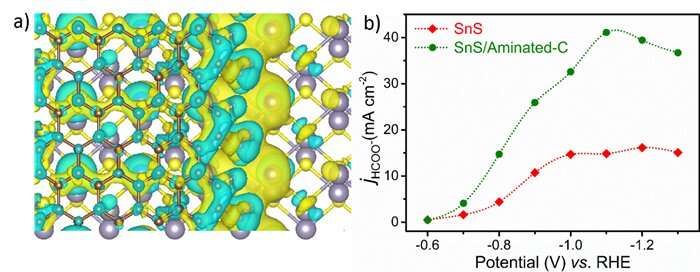The differential charge diagram of SnS/Aminated-C for (a) and the partial current density of formate production for SnS and SnS/Aminated-C for (b). Credit: CHEN Zhipeng
Carbon dioxide (CO2) emission has become a global problem. Efficient conversion of CO2 into value-added liquid fuels is one method to fix CO2, and it can alleviate the growing shortage of non-renewable fossil fuels at the same time.
The electrochemical reduction of CO2 to value-added products has obtained attention worldwide in recent years owing to its mild reaction conditions and high energy efficiency. However, it remains a challenge to achieve a large current density with a high Faraday efficiency.
Recently, a research team led by Prof. Liu Licheng from the Qingdao Institute of Bioenergy and Bioprocess Technology (QIBEBT) of the Chinese Academy of Sciences (CAS) proposed a new strategy for improving the catalytic activity of transition metal catalysts for CO2 electrocatalytic reduction.
The researchers found that directly coating the amino-functionalized carbon layer can effectively regulate the electronic structure of the non-precious metal catalyst SnS.
This approach would accelerate the electron conduction efficiency and enhance the adsorption energies of OCHO and CO2, increasing the reaction current density and formate production.
The related findings were published in Advanced Energy Materials.
More information: Zhipeng Chen et al. Engineering Electronic Structure of Stannous Sulfide by Amino‐Functionalized Carbon: Toward Efficient Electrocatalytic Reduction of CO 2 to Formate, Advanced Energy Materials (2020). DOI: 10.1002/aenm.201903664
Journal information: Advanced Energy Materials
Provided by Chinese Academy of Sciences
























